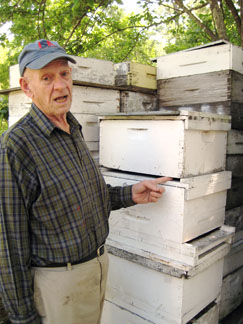Robert Biggerstaff, 72, looks in complete ease in his wide-billed cap as he leans against his garage wall and points out a cedar bee box a few yards away. A few honeybees buzz in and out, stopping at a plastic jar attached to the box. “See how that looks like a chicken feeder?… we fill that with Dixie Crystals and water to feed the bees while the hive gets going.”
We’ve been talking for awhile this morning at the center of his sideyard beekeeping and honey making operation, under the oak trees that edge a tidal creek off the Stono River on Johns Island, SC. I ask Mr. Biggerstaff if he has an apprentice, someone that he’s teaching these tricks of the trade. “No. I’m afraid beekeeping has become an old man’s game,” he says, particularly in recent decades as smaller farms have disappeared, and as mites, beetles and other pests have disrupted hives in the U.S., making beekeeping ever more challenging. In the 1960s, Mr. Biggerstaff recalls losing maybe 5% of his hives in a year, but these days a 50% annual loss is more common. He’s constantly having to manage for that reality – to bring in new queens, establish new hives. Then he tells me that while his home-based bee operation isn’t officially open for tours, as a former teacher he does enjoy making school presentations from time to time. “Children, when they see bees and learn about them, they get very excited,” he says.
And although he doesn’t put it in words, you get the feeling that he’s hoping that some young people will find the passion for beekeeping like he did, in spite of the challenges. “For years coaching was my life. Now it’s bees.”
I’m working on a story about Mr. Biggerstaff and his 40-year honey “hobby.” The former high school football coach tends 100-150 hives in 15 or so locations on the Sea Islands south of Charleston, and he and his wife, Jane, sell jars and squeeze bottles of the honey through produce vendors in Charleston and Mount Pleasant, and on Johns and Edisto islands.
– Sandy Lang, May 2008
